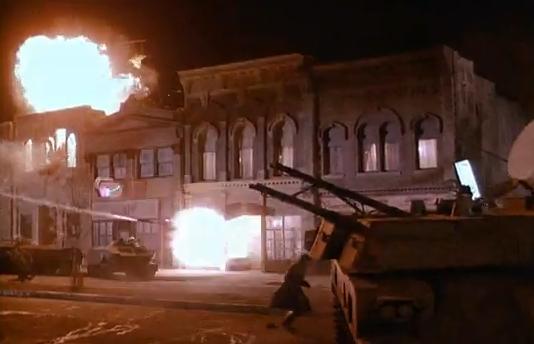 If Las Vegas, Nevada is the most unnatural, yet instantly recognizable urban film setting in the modern American West, then its bizarro counterpart is a small town of the same name in Northern New Mexico. Put on the map by a series of Tom Mix silent films, this quieter, less gambler-friendly Las Vegas began making a more modern, yet mostly anonymous, impression in 1969’s Easy Rider. In that film it’s the stand-in for a long-hair-hating Texas town where the film’s country-trekking bikers get arrested for “parading without a permit.” While the jail’s interior shots were filmed up north in Taos, the action returned to
If Las Vegas, Nevada is the most unnatural, yet instantly recognizable urban film setting in the modern American West, then its bizarro counterpart is a small town of the same name in Northern New Mexico. Put on the map by a series of Tom Mix silent films, this quieter, less gambler-friendly Las Vegas began making a more modern, yet mostly anonymous, impression in 1969’s Easy Rider. In that film it’s the stand-in for a long-hair-hating Texas town where the film’s country-trekking bikers get arrested for “parading without a permit.” While the jail’s interior shots were filmed up north in Taos, the action returned to  Las Vegas for an exterior scene where Jack Nicholson takes a hit of bourbon while framed by a large sign for Pabst Blue Ribbon. In Red Dawn, the town’s convenient location on the edge of the Rocky Mountains allows it to serve as Calumet, Colorado (which in reality had become a ghost town) – a place whose all-American values are violently challenged by some invading Soviets. A more textured, yet no less bloody, commentary on the nature of modern violence is at the heart of No Country for Old Men, which for budgetary reasons filmed large portions in Las Vegas — once again doubling for Texas. In fact, this film may indeed be the town’s finest hour for showing off its unique mixture of
Las Vegas for an exterior scene where Jack Nicholson takes a hit of bourbon while framed by a large sign for Pabst Blue Ribbon. In Red Dawn, the town’s convenient location on the edge of the Rocky Mountains allows it to serve as Calumet, Colorado (which in reality had become a ghost town) – a place whose all-American values are violently challenged by some invading Soviets. A more textured, yet no less bloody, commentary on the nature of modern violence is at the heart of No Country for Old Men, which for budgetary reasons filmed large portions in Las Vegas — once again doubling for Texas. In fact, this film may indeed be the town’s finest hour for showing off its unique mixture of Victorian brick architecture and more modern commercial and residential districts. The resulting scenes with a hypnotic noir vibe reminiscent of Blood Simple, which the Coen brothers had set and shot in Texas itself. The source material for No Country was Cormac McCarthy’s novel, and Las Vegas had previously hosted another of his several Texas/Mexico-set works: All the Pretty Horses. Yet it was the film version of a novel by Max Evans, The Hi-Lo Country, which may have best evoked New Mexico’s version of the New West. Like Horses, the dusty landscape (shot on-location in what Evans dubbed northeastern New Mexico’s Hi-Lo region)
Victorian brick architecture and more modern commercial and residential districts. The resulting scenes with a hypnotic noir vibe reminiscent of Blood Simple, which the Coen brothers had set and shot in Texas itself. The source material for No Country was Cormac McCarthy’s novel, and Las Vegas had previously hosted another of his several Texas/Mexico-set works: All the Pretty Horses. Yet it was the film version of a novel by Max Evans, The Hi-Lo Country, which may have best evoked New Mexico’s version of the New West. Like Horses, the dusty landscape (shot on-location in what Evans dubbed northeastern New Mexico’s Hi-Lo region)  genuinely conveys the clash between the area’s old ranching lifestyle, and the post-WWII economic upheaval that changed things forever. By the 1980’s, films like the Arizona-shot Near Dark helped innovate the vampire genre with a move to the Southwest — where the red sunsets framed against the desert horizon add to the dread of John Carpenter’s New Mexico-set Vampires. That film features a cameo by the 120 year-old Las Vegas Plaza Hotel as the bastion for an on-the-run vampire hunter and his prisoner. With hundreds of buildings of all styles and eras on the National Register of Historic Places, Las Vegas has positioned itself to continue playing the cinematic role of “The West.” The only question is, will it ever get to play itself?
genuinely conveys the clash between the area’s old ranching lifestyle, and the post-WWII economic upheaval that changed things forever. By the 1980’s, films like the Arizona-shot Near Dark helped innovate the vampire genre with a move to the Southwest — where the red sunsets framed against the desert horizon add to the dread of John Carpenter’s New Mexico-set Vampires. That film features a cameo by the 120 year-old Las Vegas Plaza Hotel as the bastion for an on-the-run vampire hunter and his prisoner. With hundreds of buildings of all styles and eras on the National Register of Historic Places, Las Vegas has positioned itself to continue playing the cinematic role of “The West.” The only question is, will it ever get to play itself?
2 minutes read
Las Vegas, New Mexico
2 minutes read